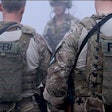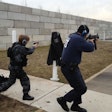I'd be remiss if I didn't acknowledge the highly successful, greatly significant U.S. Navy SEAL Team Six raid that eliminated Osama bin Laden, the terrorist responsible for murdering more than 3,000 Americans on 9/11.
I join with all Americans everywhere in saluting this magnificent accomplishment by the Navy SEALs. While the war against terrorism may not be over, terrorism has suffered perhaps its biggest blow to date.
The Osama bin Laden raid ranks among the most significant raids in modern military history. It ranks right up there with Israel's Operation Entebbe in 1976; the GSG 9 operation in Mogadishu in 1977; the Son Tay Raid in 1970; the U.S. invasion of Panama in 1989; the Delta Force operation in Mogadishu in 1993 ("Black Hawk Down"); and the U.S. military's capture of Saddam Hussein in a hole in Iraq in 2003.
History is replete with similar military raids — some have been successful, others less so — that reinforce the reality that the vast majority of such operations are rarely ever known outside a circle of the select few on a need-to-know basis.
In modern times, surgical-raid missions have become the forte of military special operations. Successful raids or searches don't just happen by accident. They require the right personnel of elite, trained, and experienced professionals. Success requires intel, authorization, planning, coordination, teamwork, tactics, timing, and execution.
Then there are the intangible, unplanned factors that cause things to go wrong at the worst possible moment. When applying Murphy's Law, woe to those who don't anticipate and plan for "Murphy" to show up uninvited.
Those in military Spec Ops and police SWAT appreciate the combined factors that make the bin Laden operation successful. It starts with accurate intel that pinpointed, and fixed, bin Laden's location. The hunt for OBL likely included many near misses and dry holes.
SEAL Team Six is so secretive, its existence isn't officially acknowledged. It was renamed as DEVGRU in 1987, and may have been given a new name in 2010 that hasn't been revealed. Whatever their name, the OBL mission, as with all their missions, is classified as top secret. So, there's little chance the details will ever be officially revealed. This level of secrecy is SOP for most Spec Ops missions.
However, once in a great while, we get a rare glimpse into a classified Spec Ops mission. Perhaps the best known in recent times was Operation Gothic Serpent. We know it as "Black Hawk Down." It ran from Oct. 3-4, 1993, in Mogadishu, Somalia.
Despite being the deadliest single combat incident since Vietnam, the Battle of Mogadishu received little news coverage, and then faded away. That is, until Mark Bowden's bestselling book and the subsequent hit movie, "Black Hawk Down."
Task Force Ranger (TFR) was the combined U.S. Army Delta Force, Ranger, air/ground support elements assigned to capture General Mohamed Farrah Aidid, a Somali warlord. Acting on intel that Aidid had been located, TFR embarked on a mission no one knew would turn into the survival fight of their lives.
There are a number of similarities between the Aidid and bin Laden missions. Both men eluded capture for a long time. Both were hiding in unfriendly territory and protected by supporters. U.S. elite Spec Ops units (Delta Force and SEAL Team Six) spearheaded the respective operations. Both were supported by air/ground elements.
Success required the same elements that hallmark most successful raids or searches.
These time-honored raid/search elements apply to both Spec Ops and SWAT and often are the difference between success and failure. Let's look at what's known about how they factor in the OBL and Aidid raids.
OBL: Initial surprise, infil to execution, appears to be total, giving SEALs the tactical advantage from the start. Surprise: infil into unfriendly territory and directly into OBL's compound undetected. Shock: capitalizing on speed by blasting through multiple barriers designed to slow down invaders. Speed: the mission — infil, execute, and exfil — was accomplished in less than an hour without interference from unfriendly elements. The mission was accomplished with surgical precision.
Aidid: Evidence suggests the initial approach surprise was compromised, allowing multiple armed hostiles to mobilize and attack TFR. Even so, TFR captured a number of targets, but not Aidid. Any shock advantage TFR might have had initially was quickly reversed, as angry mobs of heavily armed hostiles attacked TFR with a ferocity seldom seen. As a result, speed turned into a ferocious 15-hour firefight — the deadliest single-engagement combat death toll since the Vietnam War that had ended 18 years earlier. Mission accomplished? Make that mission changed — from capturing Aidid to fighting for survival.
And fight they did — with the courage, fierceness, and honor worthy of all those who have served in America's military. Just as their OBL raider counterparts had to do, the Aidid raiders were forced by circumstances beyond their control to improvise, adapt, and overcome.
Perhaps Mogadishu teaches us the biggest lesson of all — that a plan is a plan, until the shit hits the fan.
















